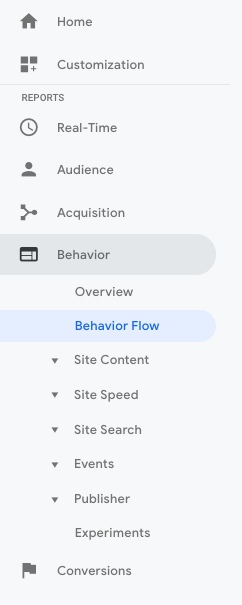Winter Apartment Marketing Outlook

Uncovering Your Prospects’ Website Journey: Part 1
- 15 May 2019

In a world full of multiple online and offline touchpoints, it’s become increasingly important for communities to understand the journey their prospects engage in before they become a lead.
Where do potential renters go to find trustworthy sources of information about your community? Which marketing touchpoints do they engage with first? Are the channels prospects go through to find your community online and in person working for or against you? Amidst this growth in complexity, marketing channels and platforms are making a greater effort to give companies more transparency and better tools to answer these questions.
One of the channels communities have the most control over in the customer journey is their website. Most communities already have the tools they need to understand how prospects are interacting with it but don’t know how to use them.
In this two-part series, we’ll help you retrace your prospects’ digital footprints so you can find out which pages on your website lead to engagement, and which lead to abandonment. In part one, we’ll show you the pages website visitors are visiting as they navigate through your website. In part two, we’ll explore the website journey that highly interested prospects took before they became a lead.
Are you ready to start your investigation?
Step 1: Log into your Google Analytics account.
Yes. that scary place with all the numbers, charts and arrows. Don’t worry, we’ll make sure you make it out of there alive.
Step 2: Enter the “Behavior Flow” page.
On the left-hand side of your account sits a menu. To navigate to the “Behavior Flow” page you’ll need to first click on the “Behavior” tab.
Once you click on this tab the drop down menu will appear underneath it. Click on the tab labeled, “Behavior Flow”.

Step 3: Select your time range.
In the upper right-hand side of this page, you have the option to select the time frame you want to view the data from. We recommend looking at at least a month’s worth of data to get a better sample. A year’s worth is more ideal.
Navigating Through Your Behavior Flow Results
Now you should have an overview of your website traffic flow. In the first column, you can see the landing pages that your website visitors are entering into your site from. In most cases, your homepage will be the landing page you get the most traffic from (your homepage will be delineated by “ / “ or “/index”).
In the second column, you will see the starting page in your website visitor’s journey, if people leave the website from this page, they will be counted as a drop-off. The drop-offs are visually represented in red. If you hover over the red flows you will see the total number of people who dropped off after visiting a given page.
The grey flows show you where the traffic moved from one page to the next. The size of the flow represents the relative amount of traffic that passed through that customer journey. On most apartment websites the largest flow will be from the homepage (and other variations of it like the index page”) to the floorplans page. In this example, the floor plans page was the second page most website visitors visited after viewing the homepage. After this page, most people went back to the homepage.
Tracking Customer Journeys by Source & Campaign
One of the more interesting features that behavior flows offer is the ability to segment website journeys by marketing source or drill down to the marketing campaign or ad level. If you change the segmenting options within the first left-hand column in white, you can navigate between these filters.
Source
If you want to evaluate the flow of your traffic by the source of your marketing traffic, you can do so by selecting “Source” from the green drop-down menu on the upper left-hand side.
Once you select this view you will see a page that looks like the one below. At this level, you can evaluate whether some traffic sources lead to more drop-offs or whether if a marketing source is bringing in the website visitors who navigate through a series of pages on your site.
Campaign
If your community is running any specific marketing campaigns, such as Paid Search, Display, Social, or Email, you should use the campaign view to segment your traffic flow. All you have to do to navigate here is search or select “campaign” (it lives under the “Advertising” heading) in the same drop down menu you used to segment by source.
To get the most out of segmenting options like these, you can opt to highlight flows of traffic that come from different campaigns. If you select on the white campaign boxes on the left-hand side, an option appears to highlight website traffic from a campaign.
Once you take this step you’ll see a highlighted flow chart like the one below. This will help you isolate the traffic flow and drop off rates specific to a given campaign and compare them to your other marketing efforts.
To return to the overview level, select the white campaign box and click on “clear highlighting”.
Interpreting Your Behavior Flow Results
High Drop Off Rates
If you’re noticing a high drop off rate on a particular page that could be an indication that your page isn’t effective or that your traffic isn’t as qualified. If you’re experiencing heavy drop-offs on your floorplans page that could be an indication that your pricing, types of units, and availability aren’t in alignment with your website traffic. If you believe traffic quality is the issue, dig deeper and uncover which campaigns have higher drop-off rates. Use this information to improve your targeting efforts. If your traffic is qualified but is still leaving your site at a high rate, it could be due to slow load times, bad website layouts or a lack of relevant information.
In the case of a one-page website, or with pages that contain the majority of the website’s information, a prospect doesn’t have a reason to navigate to another page, so communities will see a high drop off rate there.
Optimize Critical Pages
The most visited pages on your website are the most valuable pages on your website. If your average prospect only visits the homepage, floorplans page, and the gallery page, you know that those pages are critical to selling your community online. If you know which pages are the most important to your marketing efforts, you can prioritize optimizing those particular pages to get the most ROI from your site. In the examples stated above, it would make sense for that community to try incorporating gallery images of specific floorplans within the floorplan page so that prospect can find the information they are looking for right away. Communities should also ensure that call to actions are visible and relevant on critical pages so your community can maximize conversions in the places that are most likely to see the most traffic.
Conclusion
The first step to creating an exceptional customer journey is to understand the current one. We hope you walked away from this article with the skills you need to start tracking a critical component in your community’s online journey. Stay tuned for part 2, where we break down the path that led your most interested website visitors took before they converted into a lead.
Did you find this article interesting? Consider sharing it with your colleagues using the social sharing buttons located on this page.
Categories
- Auto
- Automotive Marketing
- Consumer Behavior
- Conversion Drivers
- Dealership Marketing
- Dummy
- Email Marketing
- Emailers
- Excellence
- Featured Posts
- General
- Google Adwords
- Internet Marketing
- Ipsum
- Live Chat
- Local Business
- Local Marketing
- Lorem
- Marketing News
- Marketing Research
- Marketing Strategies
- Marketing Tactics
- mobile marketing
- Multifamily Housing
- reputation management
- Retargeting
- Search Engine Marketing
- Search Marketing
- Senior Living
- SEO
- Service
- Social Media
- social media
- Student Housing
- video advertising
- Websites
The four ad mistakes that are Costing you leases
And How to Fix Them Fast!


